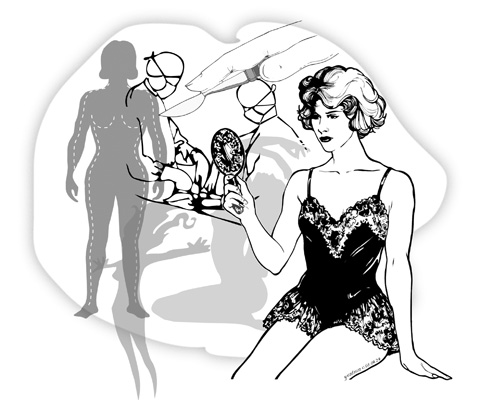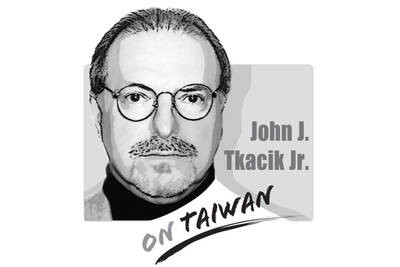For the past few months, a debate has rumbled on as to whether or not cleavage has become passe. The British model and TV personality Katie Price has reportedly had hers reduced, telling a talk-show host that she wanted to have breasts smaller than her head. Venezuela’s self-styled revolutionary President Hugo Chavez has even tried to politicize fake breasts, accusing his countrymen, who’ve been buying them as 15th-birthday presents — a girl’s traditional coming-of-age celebration in South America — of falling for that brazen cheerleader for Western consumerism, Barbie.
And now, the British Association of Aesthetic Plastic Surgeons (BAAPS) is rounding on its own. The association insists that it isn’t criticizing medical standards, rather the marketing techniques of certain clinics — the kind that use photographs of tanned, verging on spherical orbs straining at the fabric of a skimpy bikini. Placed slyly in the back of magazines whose readership is largely made up of teenage girls, the accompanying text gently undermines in order to make their audience more receptive to their seductions. Breasts too small or uneven in shape or size? We can change your life.
Those breasts are anatomically incorrect, BAAPS members claim, as if we couldn’t see as much with our own eyes. Moreover, the ads also brag about celebrity clientele and feature financial incentives for those who sign up sooner rather than later.

BAAPS criticism comes off the back of the largest survey of its kind ever undertaken, which has revealed a 175 percent increase in the number of women undergoing breast augmentation procedures in the UK over the past five years. Last year, 6,497 British women put themselves under the knife, that’s up on just 2,361 in 2002.
The figures raise all sorts of complex and damning questions (as well as a few obvious truths) about feminism’s supposed gains and the still-limited role models available to young women. Granted, there is something inherently comic about breasts. Just think about the slang they attract — knockers, boobs, hooters. Writing about them without punning is almost impossible — even those esteemed surgeons go under an acronym that will provoke sniggers up (“Baps?”). Big breasts say Carry On films, they say naughty seaside postcard, but like all good comedy, they hint at the tragic: remember Frenchwoman Lolo Ferrari, she of the world’s largest pair? Mysteriously dead at 37, her legendary assets — painful to even look at as a woman and supposedly the result of 22 operations and an aircraft engineer’s guile — went posthumously on, appearing in the American Guinness World Records book three years later.
But going back to those ads, are their airbrushed images sexy? The before and afters certainly aren’t, but even those others, the ones of the wet-haired beach babes, present such a stylized, cartoonish vision of sex, they are almost neutering. In this respect, the rise and rise of the boob job keys into a larger trend. However low decolletage may dip or a skirt climb, however backless or strapless a dress dares to be, any suggestion that a body might actually be bodily — a glimpse of cellulite, say — guarantees tabloid naming and shaming. Even an uncovered nipple is a no-no — “smuggling peanuts” is how Victoria Beckham recently described it.
But while they may be anatomically impossible, in other ways, the proportions in the offending ads are wholly accurate. The bosoms that those nip-waisted bodies support represent every half-formed hope of escape and success and love that their target audience of teens hardly dares whisper to themselves. There is not a hint of reality in their promises — those breasts are never shown stuck behind a desk or pushing a trolley round the supermarket.
And what’s more telling is that though the results are intended to appeal to men, men never feature in the advertisements. It’s just the women and their breasts, so high on their own apparent allure that they barely notice the tropical backdrop.
Even as they objectify, those ads insist that breasts are empowering — just look at tough, competent businesswoman Katie Price with her bestselling autobiographies, her myriad lines of endorsed products, and her legions of female fans. Those breasts are an aspirational tool, a means to an end — and that end isn’t sex but power. Those pneumatic-breasted sisters are no more nor less ambitious than their corporate lawyer sisters, they’re just a little more — well, upfront about it.
Which brings us to another truth we’d rather not acknowledge: There is a class question at stake here. Generally, middle class teenage girls do not aspire to big boobs, their yearning sends them in the opposite direction, towards emaciation.
The BAAPS’ campaign is aimed at steering women away from the clinics with the most aggressive marketing, but it’s unlikely to cool our love affair with the myth of perfection. The results may be as fake as reality TV, but by comparison with other dreams that the surgeon’s knife can grant — making women virgins again, for instance — a boob job seems almost innocent.
Earlier this month, the British artist Damien Hirst defied meltdown on the financial markets with a record-breaking Sotheby’s auction of his work. If ever she gets around to putting them on eBay them, as threatened, Katie Price’s breast implants will be a far more culturally significant artifact.

On May 7, 1971, Henry Kissinger planned his first, ultra-secret mission to China and pondered whether it would be better to meet his Chinese interlocutors “in Pakistan where the Pakistanis would tape the meeting — or in China where the Chinese would do the taping.” After a flicker of thought, he decided to have the Chinese do all the tape recording, translating and transcribing. Fortuitously, historians have several thousand pages of verbatim texts of Dr. Kissinger’s negotiations with his Chinese counterparts. Paradoxically, behind the scenes, Chinese stenographers prepared verbatim English language typescripts faster than they could translate and type them
More than 30 years ago when I immigrated to the US, applied for citizenship and took the 100-question civics test, the one part of the naturalization process that left the deepest impression on me was one question on the N-400 form, which asked: “Have you ever been a member of, involved in or in any way associated with any communist or totalitarian party anywhere in the world?” Answering “yes” could lead to the rejection of your application. Some people might try their luck and lie, but if exposed, the consequences could be much worse — a person could be fined,
Xiaomi Corp founder Lei Jun (雷軍) on May 22 made a high-profile announcement, giving online viewers a sneak peek at the company’s first 3-nanometer mobile processor — the Xring O1 chip — and saying it is a breakthrough in China’s chip design history. Although Xiaomi might be capable of designing chips, it lacks the ability to manufacture them. No matter how beautifully planned the blueprints are, if they cannot be mass-produced, they are nothing more than drawings on paper. The truth is that China’s chipmaking efforts are still heavily reliant on the free world — particularly on Taiwan Semiconductor Manufacturing
Keelung Mayor George Hsieh (謝國樑) of the Chinese Nationalist Party (KMT) on Tuesday last week apologized over allegations that the former director of the city’s Civil Affairs Department had illegally accessed citizens’ data to assist the KMT in its campaign to recall Democratic Progressive Party (DPP) councilors. Given the public discontent with opposition lawmakers’ disruptive behavior in the legislature, passage of unconstitutional legislation and slashing of the central government’s budget, civic groups have launched a massive campaign to recall KMT lawmakers. The KMT has tried to fight back by initiating campaigns to recall DPP lawmakers, but the petition documents they